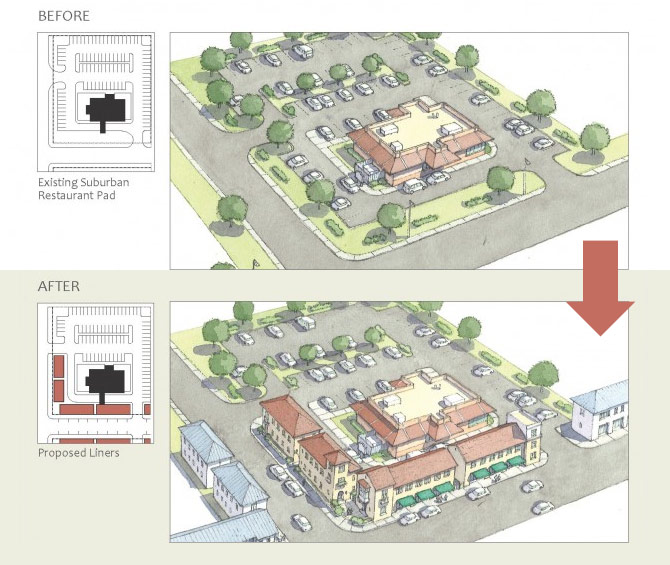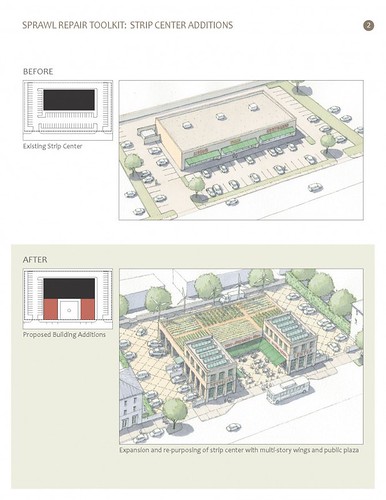Last week, I was visiting family in the D.C. area, and I was reminded how much the population density has increased in the surrounding suburbs compared to when I was growing up. If nothing else, the traffic is becoming worse and worse (it's even become more congested over the last few years--an advantage of returning home at intervals is that I can view this change as a discrete phenomenon rather than as a gradual increase).
A problem with suburbs is that, even if one wanted to add high-density, lower car-use housing, such as putting apartment buildings in places where residents can walk to basic amenities and restaurants, how does one go about doing this? (One thing that complicates this are housing and zoning regulations, but I'm assuming, for the sake of argument, that there is general consensus on the need to add such housing.) Consider 'old'* McLean (VA):

Directly above and below the "Google A" are two shopping centers (you can use the cars to give you an idea of distance). In the upper one, there are a lot of stores, a supermarket, and restaurants--kinda like my urban hellhole. It would actually be a good place to live. In fact, the building bracketed by Lowell Ave. and Emerson Ave. is a high-end apartment building. But the lower center isn't very frequently visited: there's an auto parts store, a hardware store (which is essential--my urban hellhole has two within a ten minute walk), and a discount book store. Basically, the back half of that parking lot is wasted space.
If one wanted to turn that space into high-density, lower car-use housing, how does one do it? (It gets more complicated as Chain Bridge Road is a five-lane road, although speeds aren't very high on this section due to a lot of traffic lights). Well, I present to you the Urban Sprawl Repair Kit. I like these ideas:

And this:

Because short of carpet bombing the suburbs (not desirable), we can't start over. The name of the game is intelligent infill. To be clear, I'm not advocating that we turn suburbia into midtown Manhattan. But if suburban areas want to grow--and if they don't, then they're just shifting the problem outward--they need to figure out how to not only cram more people in, but do so in a way that minimizes car use.
*I was shocked to hear someone who moved to the area recently describe this as 'old' McLean. I remember when there were still farms and very few traffic lights--there was just McLean.

Very interesting. What they detail is suburban sprawl, not urban sprawl.
Urban is already densely packed. At least that's how it is here in the northeast U.S.
The key is to ratchet developers into mixed-use development. Austin TX is doing a lot with mixed-use and, now that the train line is finally going in, transit-oriented development (use access to public transit as a selling point to businesses, revitalize areas by rerouting public transit.)
Simply put, traffic is getting bad enough that adding more roads and sprawling isn't a solution (Texas is a net donor of highway money and the Republicans love selling toll roads to the lowest bidder.)
I'm not sure I'm sold on the idea that letting traffic get bad enough that densification occurs, but so far the city has become more walkable in the past 5 years or so. Much of the progress I believe is due to the character of the people in Austin - preserving livability in the face of strong growth has been a priority for as long as I lived there. You see a little of this in Chicago, but from my view from the Green Line, it's slow. My impression is that Daley would rather keep polishing the lakefront than lift a finger to reduce the daily population churn as suburban commuters drive downtown to work, then drive home again. I suspect there's no money to be made fixing Chicago.
I've always thought "Old McLean" was in need of some serious revitalization. Great post.
McLean does need to move to higher density, but a lot of the problems are based on the suburban cul de sac design. Everyone wants to live on a side road, so you wind up with just a handful of major roads swamped with traffic and a lot of side roads that go nowhere. We used to walk around McLean a fair bit. There were a good number of back trails connecting the automotive culs de sac so we could get to the main shopping district with the Dart Drug and the Giant, to the high school and to the library without getting in a car. Unfortunately, we were often the only walkers, and, because businesses want to be on main roads, an awful lot of people were within walking distance of nothing.